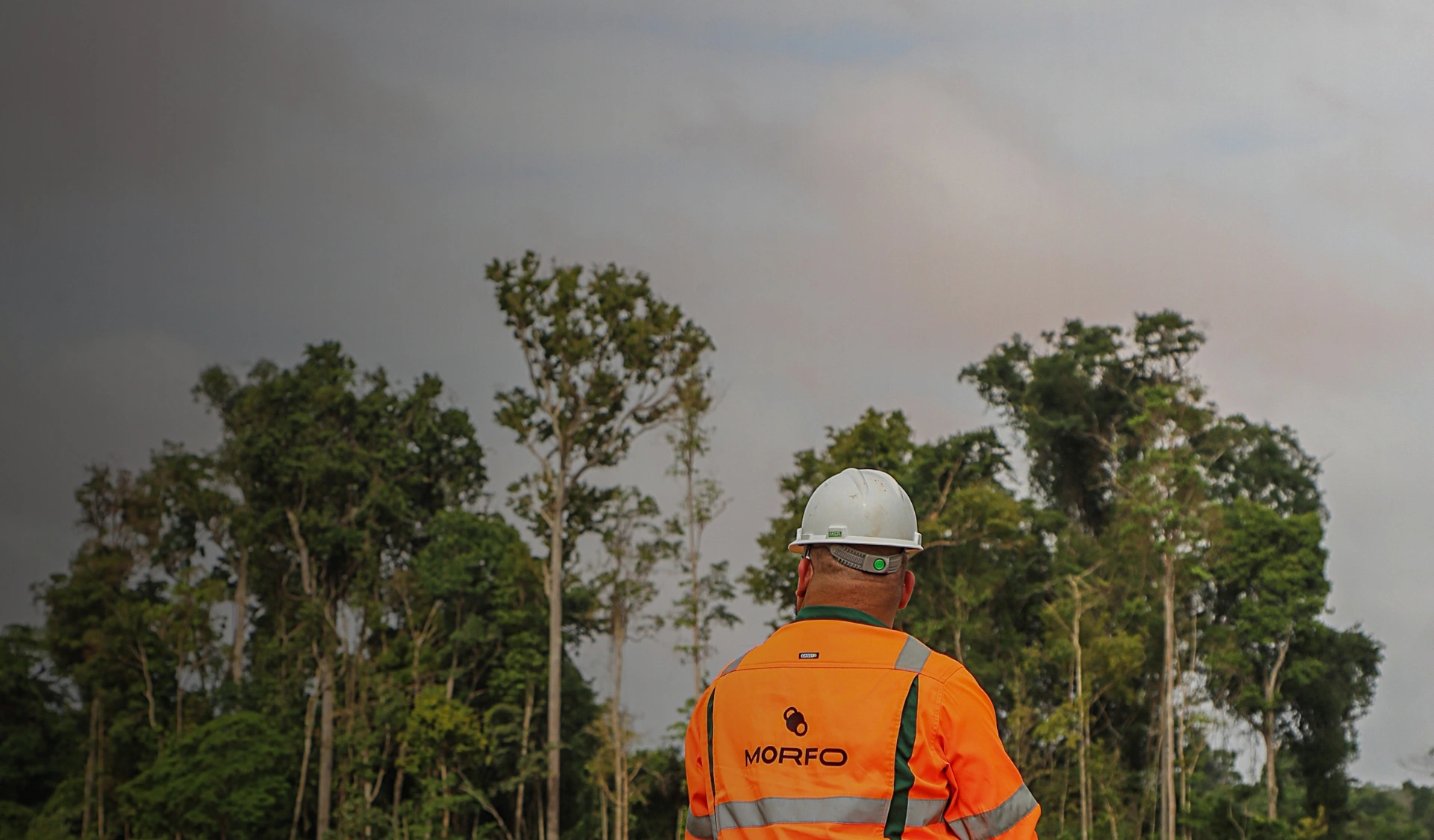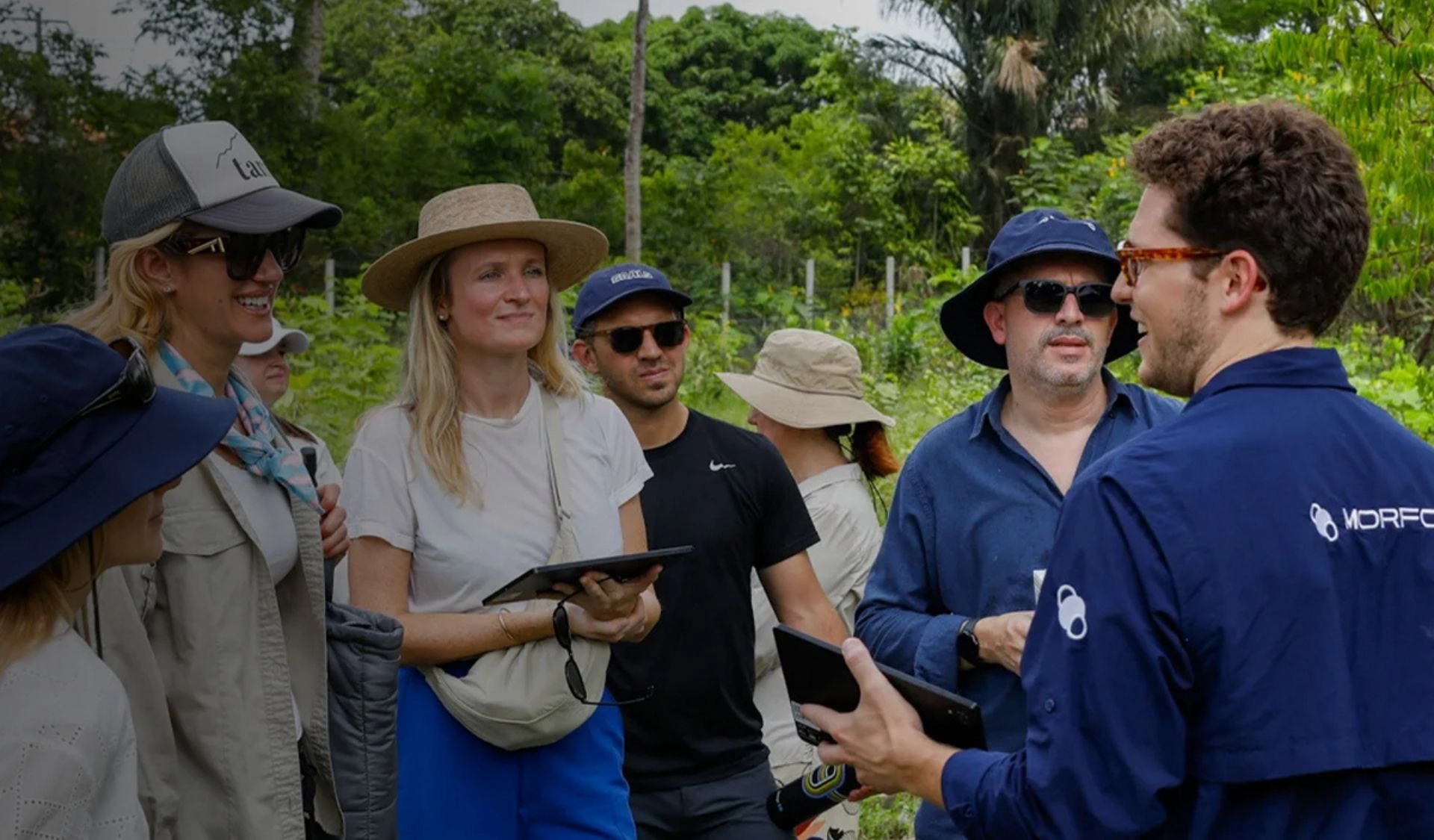Restoring forest ecosystems is a complex task that goes far beyond simply planting trees. Collaboration with local stakeholders is of great importance to the success of these projects, bringing many significant benefits, both for local communities and for the forests themselves.
MORFO, a large-scale tropical and subtropical forest ecosystem restoration service, maintains partnerships with local players for its reforestation projects. We se aside up to 20% of our projects for manual planting done by local NGOs, enabling local communities to benefit from a long-term stable income.
To date, over 1,000 people have worked directly or indirectly with MORFO on our projects in Brazil, Gabon and French Guiana, places where we are already having a positive social impact (thanks in particular to seed collection, land preparation, traditional hand planting, forest monitoring, etc.). We are convinced that this close collaboration with local stakeholders is essential to the long-term success of our reforestation projects.
In this article, you will find out more about :
- How MORFO works with local stakeholders to improve the quality of future reforestations.
- How we involve local communities at different stages of our forest restoration projects.
- The benefits of this collaboration.
The benefits for local players of working with MORFO
Partnerships with MORFOs enable integration and enhancement of local communities
Our collaborations with local players create value in two ways:
> MORFO adds value to the work of local people
MORFO's drone planting technology enables the restoration of much larger areas in a shorter time frame, therefore many more people can be involved. For MORFO, involving local communities is essential at every stage of the project.
Wherever accessibility and safety conditions allow it, MORFO consistently incorporates manual planting ranging from 10% to 30% in our restoration projects. Through this commitment, we are helping to structure and grow local NGOs and groups dedicated to reforestation and forest preservation.
In one of our projects in northern Rio, we used drones to replant 75% of the area, while local people helped replant the remaining 25%. ITPA provided us with knowledge of the Mata Atlantica biome, access to a nursery for manual planting and local workers to carry out the planting.
> Creation of stable, long-term income for local populations
Through financing reforestation projects, our local partners benefit from ecosystem restoration. We engage in long-term ecological and financial restoration. Our approach provides recurring income, fosters value creation within the region, and delivers significant social impact through job creation and the study of local seeds, among other initiatives.
One of our suppliers, Crispin, is the group leader of seed collectors for Natureza Bela, working with MORFO on a forest restoration project in the Brazilian state of Bahia.
After losing his job 15 years ago, Crispin found himself in a precarious financial situation. However, the professional opportunity to work with Natureza Bela and MORFO enabled him to get back on his feet, while at the same time offering him the chance to get involved in a vitally important cause that has a direct impact on the world.
Thanks to his in-depth knowledge of the region's fauna, Crispin made a valuable contribution by helping us select and collect the seeds needed to restore the ecosystem we were restoring. His knowledge and active participation in this project were irreplaceable.
Collaboration with MORFO maximizes forest resources, essential for local communities
Working with local stakeholders means that local communities benefit directly from reforestation projects. This can lead to an increase in available forest resources, such as food and materials, thus improving the livelihoods of local people.
MORFO takes into account the socio-economic context of each project with its partners to adapt it by taking into account aspects such as species selection, planting methods, planting and monitoring periods and duration, as well as the needs and expectations of local communities.
MORFO accelerates the operational impact of existing reforestation projects run by local players
One of MORFO's priorities is to help local players do what they already do, only do more and do it faster. Thanks to our collaborations, efficiency and speed are added to the already existing reforestation efforts of local players with the help of our technology.
Our methodical approach ensures orderly and efficient implementation at every stage of our projects. At MORFO, we have developed a drone-based reforestation technology, using seedpods, to quickly restore forests on a large scale. Our technology offers several technical benefits to local stakeholders:
- Drone technology that significantly increases planting speed.
- Access to inaccessible or dangerous areas.
- In-depth analyses, enabling us to draw up an optimal reforestation plan.
Restoring forest ecosystems improves water resources and reduces natural disasters
Restoring forest ecosystems improves local water resources in several ways. Forests act as natural regulators of the water cycle, absorbing rainwater and gradually releasing it into streams, stabilizing flows and reducing the risk of flooding. In addition, forest soils act as natural filters, purifying water by capturing contaminants and impurities, improving the quality of water available to local communities. Tree roots also prevent soil erosion around water sources, ensuring a constant supply of water for human populations and wildlife, while promoting biodiversity.
Restoring forest ecosystems also reduces the risk of natural disasters. Tree roots reinforce soil stability, minimizing the risk of landslides, flooding and damage to farmland during heavy rainfall. Appropriate forest management as part of restoration also helps to slow the spread of forest fires. Finally, forest restoration enhances resilience in the face of climate change by storing atmospheric carbon dioxide, helping to mitigate the effects of extreme weather events and increasingly frequent storms, thus protecting ecosystems and local populations.
The benefits for MORFO of working with local players
Partnerships with local players make reforestation projects more successful, thanks to their unique knowledge of local biodiversity.
In a recent study published in BioScience, the results of research carried out by Sara Löfqvist and her team at ETH Zurich highlight the crucial importance of integrating social considerations into initiatives aimed at restoring forest ecosystems. This integration encompasses aspects such as prioritizing local equity and social justice, using local knowledge, communicating clearly and adapting objectives.
The study shows that integrating local populations can contribute to more sustainable management, preserving biodiversity, increasing resilience to disturbance, conserving carbon and reducing conflict, with long-term benefits for forests and the environment in general.
What's more, local stakeholders have in-depth knowledge of the local flora and fauna. Their involvement enables projects to be geared towards preserving endemic species and restoring ecosystems in a more targeted way. They enable the planting and collection of local species that may be little-known outside local communities, thus promoting the genetic diversity of restored forests.
This is the main reason for our collaboration with local players, economic entities and NGOs. Our scientific knowledge is complemented by their extensive field experience. One practical example of this collaboration is the selection of plant species. On some projects, following discussions with local stakeholders, adjustments have been made to the list of 25 species generally planted, including the addition or removal of seeds.
Labor and seed collection by local actors are crucial for reforestation projects in collaboration with MORFO.
Partnerships with local players enable us to promote the local workforce, which is essential for :
- Analyze soil before planting for diagnosis and after planting during long-term monitoring of restoration projects.
- Prepare the soil before planting.
- Collecting local seeds.
- Nursery management for traditional hand planting.
- Manual planting, which allows us to plant seedlings that have been grown in the nursery. They make it possible to introduce species that cannot be integrated into our capsule technology for various reasons such as size, low resistance to water stress, limited seed availability or poor conservation.
We work closely with local actors to collect seeds. We collaborate with local associations to provide invaluable assistance in setting up projects, and in some cases, to help with traditional manual planting.
Collaboration with local stakeholders goes beyond planting, with long-term monitoring of forest growth.
Forest monitoring and maintenance carried out by local stakeholders is crucial to the success of our restoration projects. Our partners engage in ongoing monitoring of areas under restoration, gathering crucial data on tree health, biodiversity, soil quality and other environmental indicators.
Local players' in-depth knowledge of regional forest features, and their expertise in sustainable management, are essential to maintaining the overall health of the forest ecosystem. This approach makes a significant contribution to achieving the long-term goals of restoring high-quality forest ecosystems.
Working with local players also benefits future forest restoration
Commitment to non-governmental organizations (NGOs) is also crucial in these projects. By earmarking a significant proportion of projects for local players, you support their growth and their ability to restore more hectares of forest in the future.
What's more, by working together, we can convince more people to get involved in restoring degraded land by seeing the number of projects multiply.
Some forest restoration projects carried out by MORFO and local players
Forest restoration in collaboration with ITPA in Miguel Pereira, RJ Brazil
Read the article or watch the video:
Forest restoration in collaboration with Natureza Bela in Santa Cruz da Cabrália, BA Brazil
Read the article or watch the video:







.webp)
